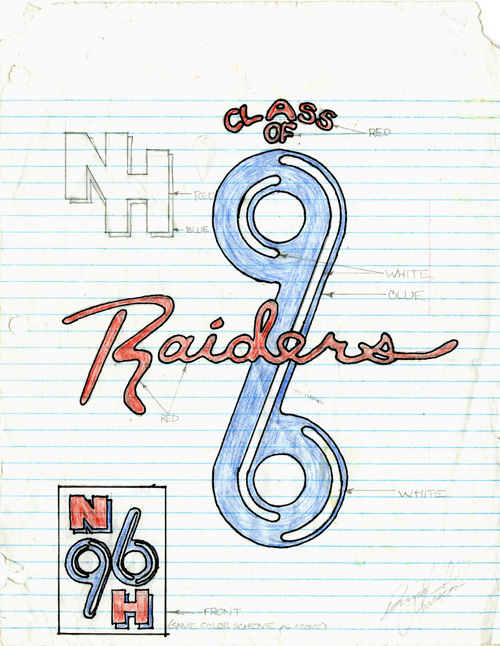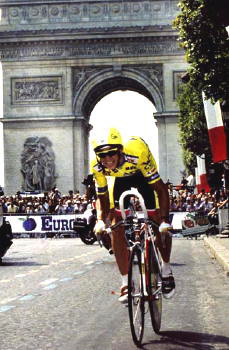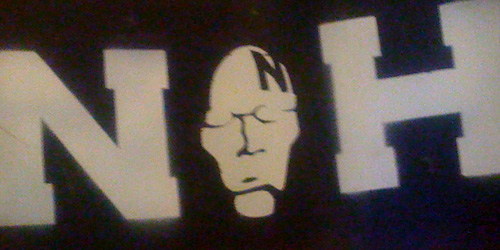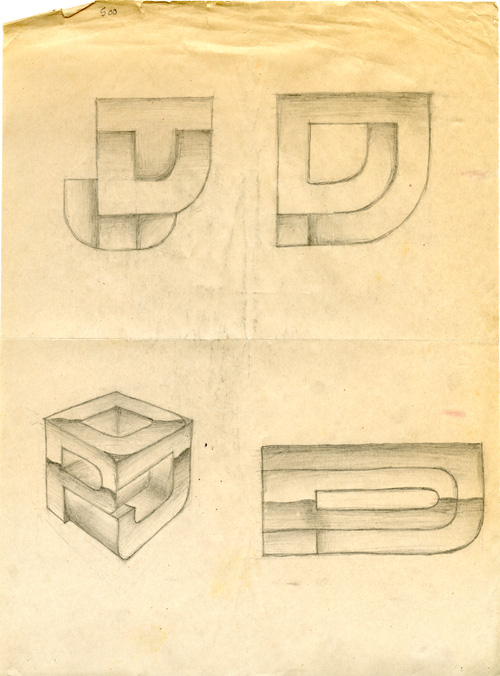Posted: 14 Nov / 2007 at 11:37 pm

cycling teams I have been on, by jersey: Liquid Sun (Perpetual Motion) / 1994-1995 and again in 1996 | Seattle Express / half of 1996 | Recycled Cycles (this is the original jersey) / 1997-1999 | University of Washington (my collegiate team) / 1998 | Ashmead College (not a collegiate team – confusing, I know) / 2000-2003 | Broadmark / 2004 – all in Seattle | Re/Max / 2006-2007 – New York
In the span of about a dozen years racing bikes, I have been on a total of seven different teams (seems like a lot, now that I think of it). Each team had its benefits and drawbacks, but perhaps the coolest team I ever raced with was Recycled Cycles in the late ’90s.
The team represented the eponymous local used bike shop, whose two owners truly loved the sport, sponsoring the team almost entirely themselves, and quite generously so. While I was on the team, it was comprised of just five to ten members who were all working class heroes of the bike world in the Clark Kent hours; most of us were either messengers or mechanics, and some were both. But, for the most part, and to varying degrees, we were also talented racers, who cared deeply for our competitive image.
Perhaps the highest compliment one can pay an American bike racer is to refer to them as “Euro.” Although this is in reference to the still-dominant homeland of professional cycling, it is is much more a point of style than results. And that Recycled team was most certainly Euro (although the results weren’t bad, either). We were built for it – wiry but tough, with narrow, chiseled features and sunken chests. We acted it, too. We wore expensive couture eyeglasses out on the bike. We spent our bottom dollars on the latest gear for our pristinely-maintained machines, but uttered nary a word on the subject. Our pedal strokes flowed like an orchestra of harpists, and our smart, contemplative gazes never wavered, even in the deepest bouts of oxygen debt. I was one of the only riders that would ever wear a helmet out training; the rest didn’t want to risk their perfect cycling cap placement (I did wear my caps out on dates, though). We had philosophical discussions about the latest Euro-pro dispatches from Cycle Sport magazine (back when it was eight bucks an issue, specially-imported from the UK, and you could only find it at one boutique bookstore in the greater metro-area). Around this time, Cannondale, an all-American bike builder, was really embracing its recent entrance into the European peloton with brilliant advertising that showed its star riders from the Italian dream-team Saeco visiting the bike factory dressed in tailored three-piece suits in a gritty, black-and-white, documentary-style print campaign (way, way pre-Sopranos). We were so inspired that several members showered, groomed and dressed in formal-wear to travel to races… Read the rest of this entry »
Filed under Identity / Systems, Uniforms / Apparel
Permalink
Posted: 31 Oct / 2007 at 11:12 pm
Going to college straight out of high school is something that you’re either supposed to do or not supposed to do, depending on who you ask. Most high school counselors want their charges to apply to every extant school they can think of and get one—any one—locked-down well before graduation, lest the youngsters dizzy themselves at their flying mortarboards, wander off, and never find their way back on track. Everyone else with an opinion says that high school grads should travel the world. (It’s always “travel,” and always “the world.” Never mind traveling to just one place, or just somewhere one isn’t from, even if it’s in the same country. And don’t even think of getting a job or building a boat – it’s travel, son.)
But I’ve only gained these insights secondhand or after the fact, because I never asked anyone in my time. I just went – 25 minutes away from my house – to the University of Washington.
I think I was too close to my new school cartographically to be so far away cognitively; it was a neurological short-circuit: How could I ride my bike straight through an intersection I only three months before had used to turn left and, eight minutes later, land on another planet? I began to dislike my UW experience very shortly after it started. It felt big, cold, and impersonal, and, while I could at least appreciate the esteem of the faculty (from afar), I was surprised at how unimpressive my classmates seemed to be. Most of my friends from high school had indeed either gone to some obscure university, or some obscure country, or they had completely lost their way. My only extracurricular activity was a disappointment. My brain and my mind were at odds with each other. These were the first two years of my college experience.
It wasn’t until I finally began the screening classes for the Visual Communication Design major (VCD) that I really began to see the potential of the school. These classes, used to fish out the top-20-or-so design candidates from a pool of 150 – 200 applicants every year, were brutally competitive but highly intriguing. They were a window into how the program would be (if one made it in), and the view looked pretty interesting. The major, established decades before “design” fell simplistically into the lexicon of quotidian banter, was a pioneering force that had created a self-perpetuating standard of excellence. The faculty were not only esteemed, they were uncompromising, and the best students were no less than inspiring… Read the rest of this entry »
Filed under Identity / Systems, Print / Editorial, Type / Fonts
Permalink
Posted: 15 Oct / 2007 at 8:37 pm

Nathan Hale Class of ’96 Raiders proposal for commemorative T-shirt design; pencil and pen on notebook paper; 8.5 x 11in. / 1996
In his song Life, Jeffrey Lewis, one of my favorite musical artists, relates each major defining factor of life (friends, love, global cultural differences, God, etc.) with a pithy verse each. The whole song is probably about two-and-a-half minutes long, and, even though it is sung of his own experience, it captures the entirety of modern life more eloquently than anything else I’ve ever heard or read at any word count. In his verse about school, he shares:
School is the place where I did my growing
They fill your brain to overflowing
They tell you this is all stuff you need to be knowing
School is the place where I did my growing
Just when I got to like it, it was time to be going
I could certainly see my entire scholastic experience in this light, but my high school days in particular are what this conjures most. Coming from middle school, which I only got to like when it was time never to have to come back, high school barely outperformed my then deflated expectations at the beginning. I was processed by generic classes and distracted teachers. The halls sucked me from one hour of it to the next until it was over for the day. The mile and a half commute passed under me each day until the week was over.
But as those weeks turned into months and and quarters, glimmers of hope began to energize my steps, and vice-versa. I was exposed to the potential of my experience, and I began to gain confidence and venture into it… Read the rest of this entry »
Filed under Identity / Systems, Type / Fonts, Uniforms / Apparel
Permalink
Posted: 14 Oct / 2007 at 7:36 pm

The ultimate inspiration: Greg LeMond (here on his way to winning the 1989 Tour de France). photo by Cor Vos
I’ve always been interested in cycling to some extent. I always rode bikes, and even before my teens, I watched big races like the Tour de France when they were on TV, and I spent my fair share of time staring at the top shelves of local bike shops and fogging up their display cases. This—unlike most—was an interest that grew steadily stronger with age. But it was an ironic turn of events that launched me into a full-blown obsession with cycling: I got hit by a car while riding my bike.
I was commuting to high school sophomore year on my Specialized CrossRoads Cruz hybrid bike (about $250 new, then) and, as I rode across a busy intersection, I was struck by a Volkswagen Scirocco (one of my favorite cars at the time), whose driver had run a red light in the rush of the hour. The impact instantly broke both of the bones in my lower left leg (although I didn’t realize this until I tried—and failed—to walk away from the scene). It’s said that people can’t recall the actual sensation of pain, but I can say with absolute certainty that having to move my broken leg into several different positions on the X-Ray table later that day was the most excruciatingly painful experience of my life. The breaks also ran perilously close to the bones’ growth plates and, if they had been damaged, this situation would have been even worse, as I still had a good six or seven inches to grow. This was not the last time that I would get hit by a car, and it’s not an experience that I would recommend to anyone, but there is usually one considerable upside: the insurance settlement. On top of paying for all of my medical bills, the sum allowed for the purchase of my first bona-fide road-racing bike: a Cannondale R900 (about $1,800 new, then).
Since they are so expensive and complex (especially compared to, say, a basketball), just getting a good bike can be a hurdle high enough to trip up a considerable percentage of potential racers and enthusiasts. Clearing this hurdle allowed me to start racing, and it was also a huge factor in the procurement of my job at a prominent local bike shop. By the time I hit senior year, I was in cycling up to my eyeballs. I rode everywhere, all the time; I was on a team; I raced as often as possible (about 50 – 60 races per year); I worked on bikes with other racers and cycling aficionados at the shop; I read every magazine and brochure cover-to-cover; I watched video tapes of every European road race fit to be filmed; I went to bike shows and bike parties… Cycling had basically permeated every aspect of my life. It didn’t take me long, then, to figure out what I was going to do for my high school Senior Project.
The parameters of this assignment were relatively broad and simple: write something, do some community service, or create some kind of artwork. The project was to take at least 40 hours (all outside of school), and it would count for approximately half of that year’s grade for my two most important classes. The goal was equally simple and daunting, as laid out by my professor—a quite scholarly Scott who had been a quadruple-major university graduate, among many other improbable accomplishments: “Impress me.” I figured that there was no way I was going to impress anyone without at least impressing myself, and the most impressive thing I could think of was to build a bike… Read the rest of this entry »
Filed under Identity / Systems, Industrial / Product, Type / Fonts
Permalink
Posted: 10 Oct / 2007 at 2:13 pm

Nathan Hale (NH) High School Swim Team logo; spray paint stenciled on paper / 1994
When I got to high school, it wasn’t a very good scene: I was short, fat, slow, uncoordinated and keenly aware of all of these things. I was also overwhelmed by boredom with my classes and mates and hid myself as well as possible so as not to be dragged into the morass of class discussion. So, how does a chunky, nonathletic, awkward guy with an invisible personality play his cards in high school? That’s right, he straps on a Speedo and joins the swim team. I still remember those first steps out of the locker room onto the pool deck as some of the more terrifying of my life.
Somehow, though, over the next few years, I would get in deep with the team. Aside from the year my leg was broken, I swam in every single practice and every meet. I got into incredibly good physical condition (I grew about eight inches from freshman to senior year, but my body weight remained almost the exactly same throughout). I was even voted captain two years in a row, which probably said more about my personality than my swimming prowess, which was okay, but no match for the purebreds.
All this engendered in me a strange new feeling: school pride. Nathan Hale was home to the Raiders and, somewhere along the way, I actually considered myself as such. But if I was a Raider, I wasn’t one of those red-white-and-blue caricatures in skinny pants, piano coats and a funny hats, reduced to hokey cartoons in the halls. That scene was so far removed from the times that a teenager could barely imagine how or why it happened, not to mention understand what it meant. In a way, it seemed that it must have just been a tale meant to fulfill the requisite mascot needs of high schools around the country 200-some years later… Read the rest of this entry »
Filed under Identity / Systems, Signage / Display
Permalink
Posted: 07 Oct / 2007 at 5:37 pm

DPJ monogram studies, pencil on newsprint / 1993
Perhaps the most difficult task for any designer is to create their own “identity,” which, in common design terminology, is usually defined by a logo and some consistent “visual system” that unifies any and all communications and media within some sort of graphic motif. (An actual identity for any entity involves far more than a logo and visual system, but that’s another topic.)
While most designers have created scads of logos for clients, or at least for school projects, there are several factors which make designing one’s own logo a challenging prospect: You don’t want to look too specialized or hung up on one particular aspect of design or a particular type of business (lest you be seen as ignorant of everything else), you don’t want to base your identity on a rising trend (as they almost always fall faster and more explosively than they grew), you don’t want to seem gimmicky, AND, you don’t want to look stupid in front of all of your design colleagues… Read the rest of this entry »
Filed under Identity / Systems
Permalink
Posted: 22 Sep / 2007 at 8:53 pm
There are certain figures who are determined to have an impact on one’s life: Their parents, their teachers, their coach, their camp counselor; these are all people who essentially signed up to help shape a young person’s future—for better or worse—and their influence is usually quite compelling. But often, it seems the ones who just happen to be in a certain place at a certain time figure most in the development of another. This is the ground of peers: classmates, neighbors, friends. The most hallowed of this ground, of course, is that of the best friend.
My best friend growing up was a kid my age named Charley. We happened to go to the same (very good) inner-city elementary school, where we were not much more than acquaintances. But we also happened to go to the same (very mediocre) rich-yuppie middle school on the hill, which turned out to be a friendship-making fluke. Of course, we also happened to have a few similar interests and philosophies on the most important issues of our time (you can imagine what those might have been in seventh grade).
More than anything else, Charley was cool. He looked cool: tall and stately from the day he was born. He had cool clothes. He had cool things. He listened to cool music. He lived in a cool house in a cool neighborhood. He even had cool parents: His dad was a real, long-haired, tattooed biker who built and rode his own choppers, and his mom seemed straight out of a hip family TV show. He was funny and sharp, and he had cool stories that he knew exactly how to tell. Charley also seemed to do the coolest things. And, though I hardly noticed it at the time, these were an enormous influence on my life… Read the rest of this entry »
Filed under Identity / Systems, Type / Fonts
Permalink




